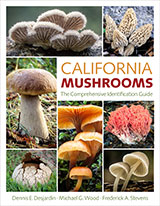The North American Species of Pholiota
184. Pholiota subtestacea (Murr.) comb. nov.
Hebeloma subtestaceum Murrill, North Amer. Flora 10: 226. 1917.
Illustrations: Text figs. 412-414.
Pileus 8 mm broad, 5 mm high, broadly conic, not fully expanding, umbonate, pale testaceous on the umbo, paler elsewhere, viscid, margin fibrillose from the evanescent veil, incurved.
Lamellae adnate, white to subfulvous, broad, rather distant, edges entire and concolorous.
Stipe 3 cm long, 2 mm thick above, 4 mm below, stramineous, with loose tufts of testaceous fibrils from the remains of the fibrillose, evanescent, testacteous veil.
Spores 5.5-7.5 x 4-4.5 µ, smooth, no germ pore evident; shape in face view oval, in profile obscurely inequilateral; color in KOH ochraceous tawny, in Melzer's reagent dingy ochraceous; wall about 0.25 µ thick.
Basidia 4-spored, 18-22 x 5-6 µ, hyaline in KOH and Melzer's reagent, somewhat clavate. Pleurocystidia very abundant, 40-56 x 8-16 µ, broadly fusoid-ventricose, apex obtuse to subacute, tapered to apex from broadest point; wall thin and smooth, hyaline; content "empty" or with a few rods and particles of refractive material in the upper part, rarely bifurcate at tip. Cheilocystidia similar to pleurocystidia, 30-38 x 7-8 µ. Caulocystidia none.
Gill trama of a floccose central strand of subparallel hyphae somewhat ochraceous in KOH, thin-walled, cells becoming inflated; subhymenium a gelatinous layer of narrow interwoven hyphae. Hypodermium a conspicuous zone of dark brown (in KOH) hyphae some with incrusted walls. Clamp connections present. All hyphae inamyloid.
Habit, Habitat, and Distribution: On soil, Jamaica, December-January; type studied.
Observations: The testaceous colors of pileus and veil are distinctive. In other features it somewhat resembles P. subflavida and P. carbonaria. The rather distant lamellae, occurrence on soil and southern distribution distinguish it from the latter. The pleurocystidia distinguish it from both. They are very abundant and lack the long neck of the typical "Flammuloides" species.

